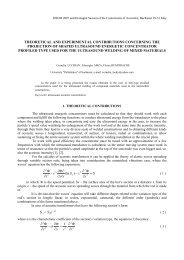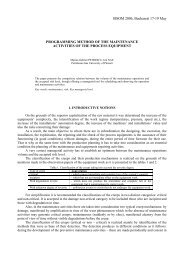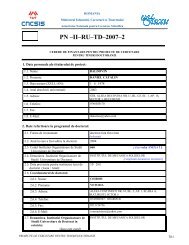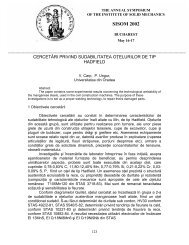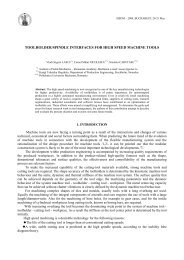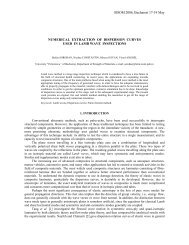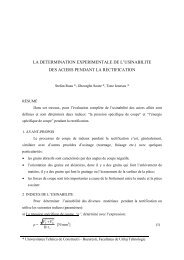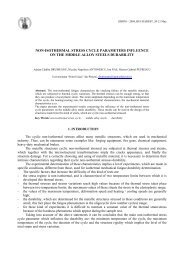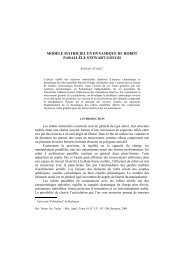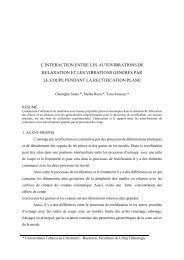GEORGE CONSTANTINESCU' TORQUE CONVERTER ANALYSIS ...
GEORGE CONSTANTINESCU' TORQUE CONVERTER ANALYSIS ...
GEORGE CONSTANTINESCU' TORQUE CONVERTER ANALYSIS ...
You also want an ePaper? Increase the reach of your titles
YUMPU automatically turns print PDFs into web optimized ePapers that Google loves.
85<br />
George Constantinescu’ Torque Converter analysis by Simulink<br />
- G represents the action of gravity on the system,<br />
- r t represents the external torques (generalized forces) applied on the system.<br />
()<br />
2<br />
Following, the physical model shown in figure 2 is analyzed for initial dates: J = 0.<br />
kg ⋅ m ;<br />
1<br />
5<br />
2<br />
J<br />
2<br />
= 10kg<br />
⋅ m ; m3 = 5kg<br />
; OA = 10mm<br />
; AB = 100mm<br />
; AC = 500mm<br />
in two working condition<br />
actuation: 1 – prime mover with constant speed; 2 –prime mover with constant torque.<br />
[ Nm]<br />
M 2<br />
Figure 5. Output torque diagram ( )<br />
M 2 ω 2<br />
ω 2 [ rev / min]<br />
3. PRIME MOVER WITH CONSTANT SPEED ACTUATION MECHANISM<br />
For prime mover with constant angular velocity n<br />
1<br />
= 3000rev<br />
/ min (par example electromotor) and<br />
load torque M = 2<br />
0... 7000Nm , linear varying with respect to time ( t ) , the angular velocity diagrams for<br />
levers 5, 7 and unidirectional mechanism 2 are depicted in figure 4.<br />
The output torque diagram with respect to output angular speed ω is depicted in figure 5. The<br />
M 2<br />
2<br />
input torque diagram M1<br />
with respect with to output angular speed ω 2 is depicted in figure 6.<br />
[ Nm]<br />
M 1<br />
Figure 6. Input torque diagram ( )<br />
M 1 ω 2<br />
ω 2 [ rev / min]




